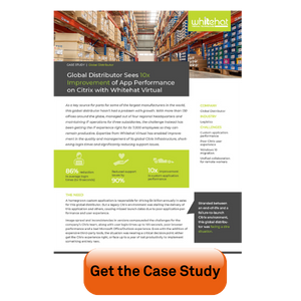Did you know the technology that provides the best user experience for remote work was born over 30 years ago?
In 1989, Citrix was born, one of the first software companies to offer the ability to run any application on any device over any connection. Fast forward to 2006, and VMware introduced the term 'VDI' to describe their virtualization products.
It wasn't until COVID-19 forced most people around the world to a remote work environment that VDI became a household name. After that, everyone had to figure out the best path forward for a remote work environment, and it's estimated that the adoption of virtualization technology grew 17% as a result.
What are the reasons behind the double-digit growth in such a short time?
Why Do Companies Buy VDI for Remote Work?
If the PC (including Mac) has become the standard compute device people use to get their work done, why do companies buy VDI? Virtual desktops have some super-powers and can support use cases that make it superior to a personal computer in many, but not all, circumstances.
But why do companies buy Citrix Virtual Apps and Desktops or VMware Horizon? What are some compelling reasons and use cases that make this technology more attractive than a plain ol’ PC? There is clearly something to VDI as the technology is estimated to have created $7.6 Billion1 in revenue in 2020 and is expected to be between $15 and $30 Billion in value by 20262, depending on the source.
Would you like to see VDI in action and talk with a VDI expert? Schedule a call with us:
7 Things a Virtual Desktop Does Well for Remote End Users:
#1 End User Experience
Work from anywhere with a good user experience. You can stay connected with all your applications, wherever you choose to call your office just like sitting at your desk, even answer your phone if you want to.
#2 Device Agnostic
Virtual desktops can follow you anywhere in the world there is reasonable internet access. You can access the virtual desktop from a tablet, phone, laptop, thin client, or Mac.
#3 Lower Support Costs
Support costs go down because VDI environments can typically be supported by a smaller IT staff than traditional PC environments.
#4 Security
Security goes up because data never leaves the datacenter. There is no need to worry about every hard drive in every computer holding any sensitive data. With VDI workspace, nothing lives on the end computer.
#5 Environment Flexibility
Work in hostile environments where PCs cannot survive with thin clients.
If you're interested in Manufacturing IT services, download our case study:
Protect intellectual property working with contractors, partners, or a global workforce.
#7 Meet Regulation Requirements
With virtual desktops, company data never leaves the data center. Those with regulatory requirements to protect client/patient data appreciate this feature as there is never a concern about data getting loose in the wild from a lost or stolen laptop or retired PC.
There are many use cases that demonstrate the value of VDI. If you have time, review some of the cases below. If you don't have time, schedule some time with us in the future:
Additional VDI Use Cases:
Homogenize the endpoint
Write one application for one platform and deliver it to many different types of endpoints. Companies do not want to write an application for Mac, iOS, PC, Android, Linux, etc. They write it for Windows/Linux and can deliver the one application to any endpoint.
Improve the speed and end user experience when delivering a heavy legacy application
Legacy applications are written “heavy” in terms of resource consumption and can get more sluggish the farther the end user is from the data center. Companies use published applications or VDI technology like Citrix CVAD or VMware Horizon to strip everything away but the essentials, screen pixels, keyboard, and mouse clicks, to deliver the best possible experience over the Wide Area Network or internet to deliver a good end user experience.
Work with computers in environments traditionally hostile to delicate computer equipment
On a farm, in a field, on an oil field lease, or on a manufacturing floor in a factory where heat, oil and grime normally kill computers.
Work where multiple people need access over low bandwidth connections
-Satellite connections to ocean drilling rigs or ships
-Small town locations with poor bandwidth choices
-Access over a 4G hot spot
-Bank branch locations in smaller towns
-Airports
-Hotels with poor Wi-Fi
Labor Cost Improvement
Often in parallel to the previous point. Needing to reduce cost by using low-cost labor in other countries can introduce security risks. As the data never leaves the data center, this is a viable option to get inexpensive labor to do work without putting data at risk.
Meet compliance requirements protecting data
Every Windows or Mac computer with data stored on its hard drive is a potential data risk. Encryption helps, but not if it is unlocked or broken. With all key data in the data center, the importance of protecting all company physical computers is greatly reduced.
Enable a BYOD policy
Provide a stipend and let users use whatever they want for a computer; they carry the support burden. The company provides the apps and compute, and the employee provides the computer. The employee gets more flexibility in the tools they use; the company gets reduced support costs as hardware issues now belong to the user.
Allow for better remote office solutions
Work from home doesn't work for everyone, but neither does a long commute. Co-working spaces are thriving, and VDI gives remote workers the option to work in shared environments without causing a security risk.
Reduce IT support costs by getting consistency at the support desk
If done well, it takes fewer support people to take care of IT infrastructure in this model by up to a factor of 10x people supported per Tech.
Deliver the corporate applications where it makes sense strategically for the business
-A bank might want to setup at tent at a public event and open new accounts
-A financial advisor might want to staff to the homes of high-net-worth clients
-An insurance company might want to put connected adjusters in a disaster area for claims
-A school might want to setup a temporary class in the cafeteria or at an alt location
-COVID might force a company to send everyone home to work temporarily or permanently
Deliver a good IT experience in a highly mobile environment
Healthcare is a great example where staff are frequently moving between rooms or across computing endpoints and need their documents and personalization’s to follow them around across computers and locations.
Anyone with a use case that needs access to their company desktop on a multitude of devices. A corporate PC, a laptop in their bag, their phone in a pinch, the all-in-one PC in the kitchen at home, etc.
Avoid hardware costs
Keep the endpoints and farm out the datacenter to a provider or public cloud company like AWS, Google Cloud, and Azure.
Employees can see VDI as a tool to allow them to work from anywhere, but past the support savings and security, companies like VDI for remote workers because it allows them to put the employee as close as possible to their customer, give them options on "work from anywhere" and when employees are happy, so are the customers.
With VDI, all your applications, all your files, your phone, your Zoom and GoToMeeting sessions, etc. all go with you. If you have internet, you can go just about anywhere.
Cost and complexity have come down as new ways to acquire and use technology. As a result, companies are leveraging VDI technology not just to survive COVID, but to give workers what they want and what they deserve: A hybrid work environment.








Leave Comment